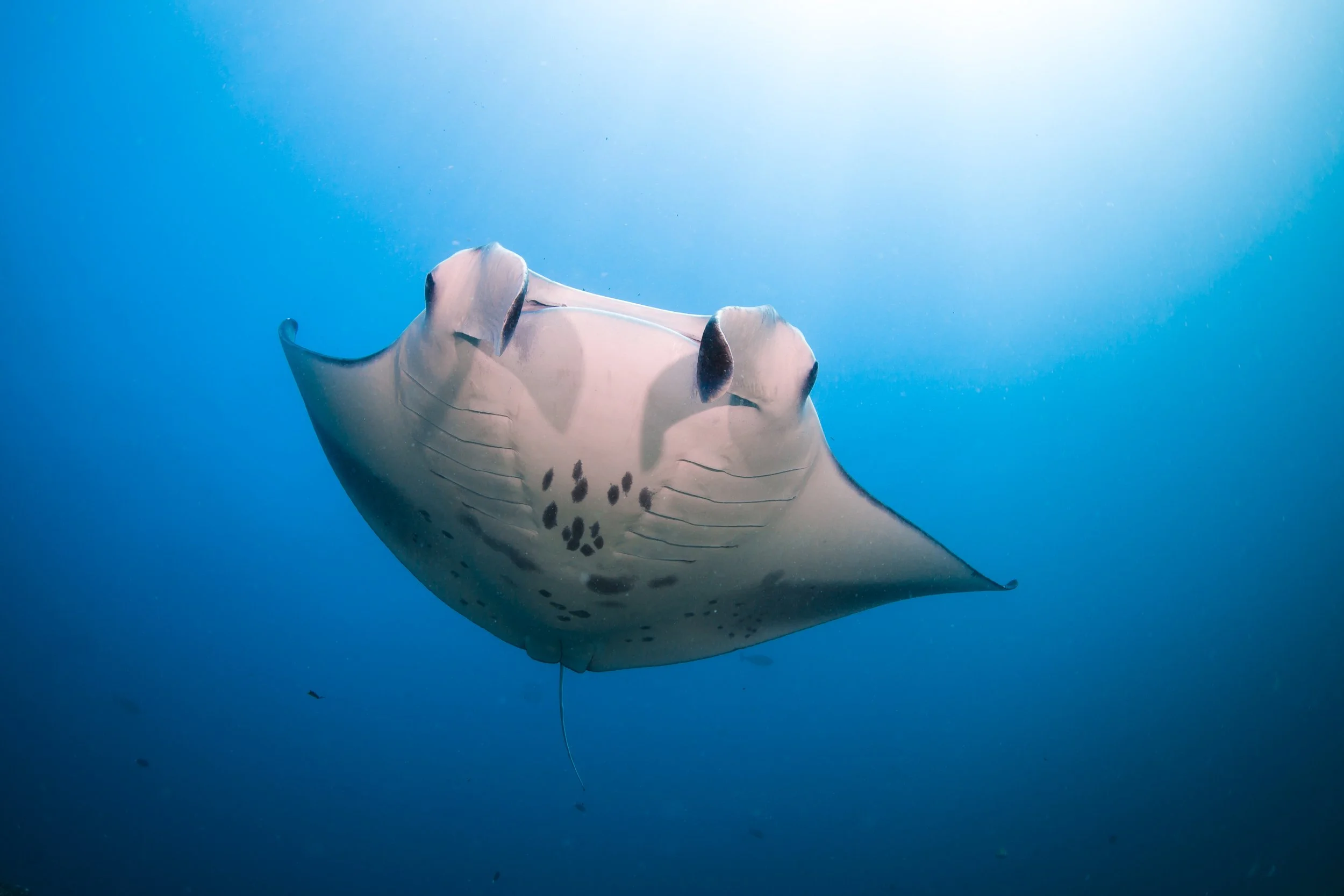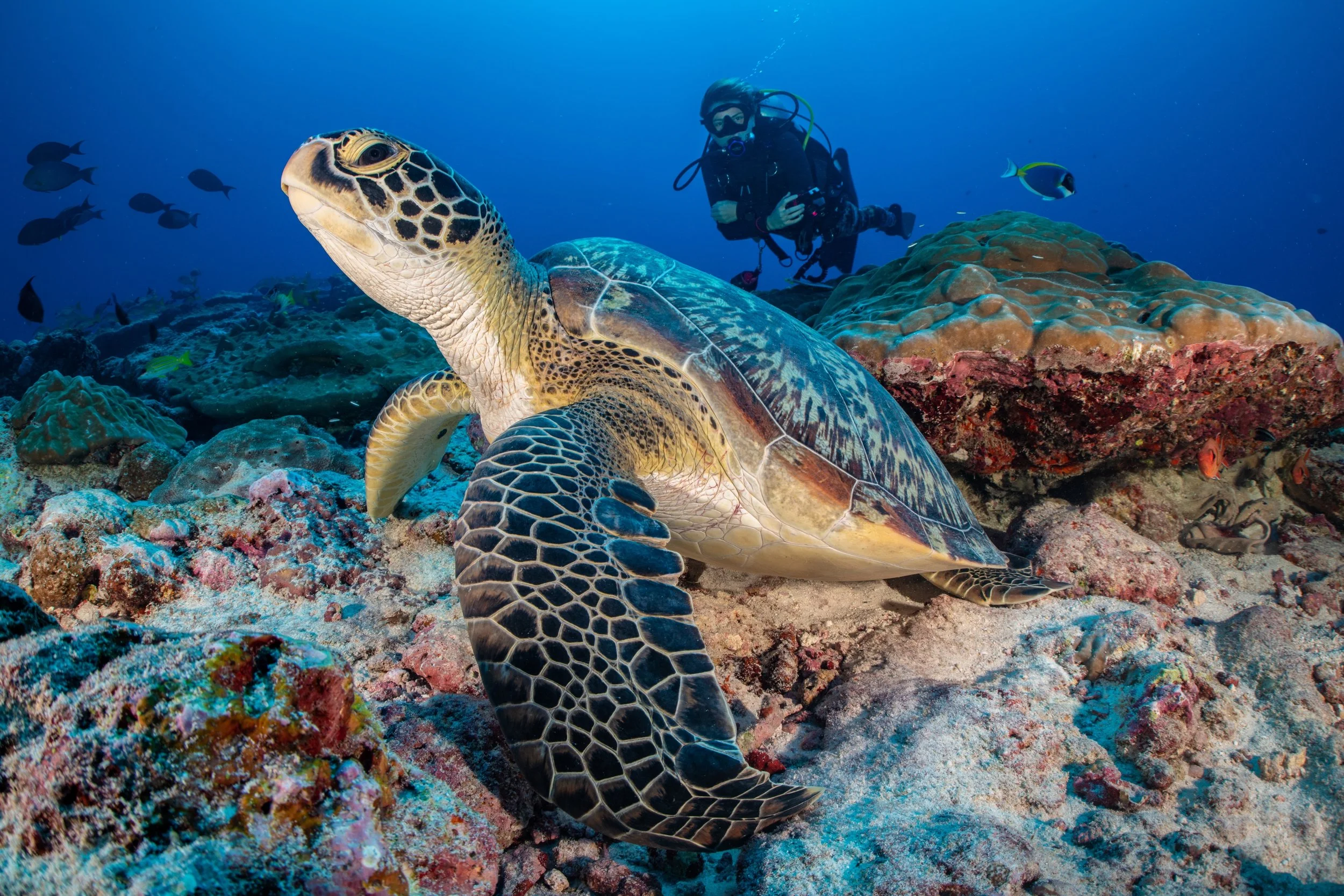By the CEO of Extraordinary Escapes – 23 years selling the Maldives, 341 days spent researching the Atolls, and a lifelong passion for marine life.
The Ocean’s Greatest Treasure
Encountering the magnificent marine Megafauna of the Maldives has been on many people’s bucket list for a very long time. Whether it is snorkelling or diving with one of these majestic animals, it is an experience you will remember for the rest of your life. Since starting Extraordinary Escapes 23 years ago, we have always had clients wanting to book their Maldives holiday with the objective of a Megafauna encounter. However, over the last 12 months, there has been a huge increase in clients with this as their primary goal. With World Manta Day this week, I thought there is no better time to look at why this is increasing and what is the effect of this increase. Also, where should you go and who should you trust with your experience.
The Maldives is synonymous with turquoise lagoons, white sand beaches and luxury resorts. For me, the real luxury is beneath the waves. Here, the reefs and channels are home to the Maldives megafauna, the large charismatic marine animals that more and more guests are wanting to travel to the Maldives to see.
“Today, the most common question I hear is no longer ‘Which island has the best spa?’ but ‘Where can I swim with whale sharks and manta rays?’”
This shift tells us something important about how travellers are changing — and why it matters for the future of sustainable tourism.
What Is Maldives Megafauna?
Maldives megafauna refers to the large, charismatic marine animals. For scientists, these marine megafauna are vital indicators of reef health and ocean ecosystems. In the Maldives, some of the most sought-after encounters include:
Manta Rays – graceful filter feeders with wingspans up to 7 metres. The Maldives is home to the largest known population of Reef Manta Rays in the World.
Whale Sharks – the world’s largest fish, yet completely gentle. Filter feeders, feeding mostly on plankton.
Turtles – Hawksbill and Green turtles glide through reefs year-round. Hawksbill turtles are commonly seen on reefs feeding on sponges and corals. Green turtles are more often spotted grazing on seagrass beds. Both species are endangered but have healthy populations in the Maldives.
Sharks – including Blacktip, Whitetip, and Grey Reef Sharks, Nurse Sharks and more rarely Tiger Sharks and Hammerheads.
Dolphins & Pilot Whales – The Maldives is home to both Spinner Dolphins and Bottlenose Dolphins. Pilot Whales are occasionally seen in deeper waters.
Other Rays: Eagle Rays, Sting Rays, Pink Whipray and Cowtail Stingrays. All incredible animals to encounter and the Maldives is one of the World’s richest destinations for rays.
Why the Desire to See Megafauna Is Growing
The Maldives has always been a popular destination for marine life encounters, but in the past year in particular, the demand has skyrocketed. I have clients coming to me asking me specifically to swim with a Whale Shark, not referencing any other megafauna. Why is this?
Social Media Inspiration:
Instagram reels of manta rays barrel-rolling at Hanifaru Bay or whale sharks cruising past snorkellers have gone viral. These moments inspire thousands to book Maldives trips.Experiential Luxury:
Today’s traveller values memories over possessions. Swimming with a whale shark isn’t just an excursion — it’s a once-in-a-lifetime story.Documentaries & Awareness:
Series like Blue Planet II and Our Planet have ignited global curiosity about ocean giants, turning passive viewers into active explorers.Improved Access:
Seaplanes and domestic flights make the more remote hotspots like Baa Atoll and Laamu Atoll easier to reach than ever.
Are Expectations Becoming Unrealistic?
Here lies the challenge. Guests often arrive with high expectations: whale sharks circling the boat daily, manta rays a guarantee. These are wild animals and their can be no guarantees.
Whale sharks are migratory and can be elusive.
Manta rays follow plankton blooms, which depend on moon phases and currents.
Dolphins may appear daily — or not at all.
Unrealistic expectations can turn wonder into disappointment. The solution is education: helping clients understand that while sightings can’t be guaranteed, the experience of seeking megafauna with expert guidance is extraordinary in itself.
Who Can You Trust With Your Megafauna Experience?
With resorts across the Maldives advertising manta and whale shark excursions, travellers face an important question: Who should I trust with my marine experience? The answer: science-led conservation organisations that combine guest engagement with research.
1. Manta Trust
The Manta Trust in a non-profit organisation established in 2011 by marine biologist Guy Stevens. Guy Stevens had previously founded the Maldivian Manta Ray Project (MMRP) at Four Seasons Landaa Giraaavaru in the Baa Atoll in 2005 as a site for long term research into Manta Rays. It was here at the Four Seasons Landaa Giraavaru that I personally met Guy Stevens and went out with him on a research trip to Hanifaru Bay.
Hanifaru Bay in the Baa Atoll is one of the Maldives most magical places. From May to October, ocean currents funnel plankton into this bay drawing in hundreds of Manta Rays to feed, joined at times by the gentle giant whale shark. It is a rare natural event, making Hanifaru Bay one of the best places in the world to witness marine megafauna in action.
My time at Hanifaru Bay with Guy Stevens was my first experience with a Manta expert and one I have always remembered. Guy was free diving with a camera, taking photos of the Manta Ray’s individual bellys, as each has a unique spot pattern akin to a human fingerprint. We went back to the laboratory and after analyzing the photos Guy could tell that we were swimming with at least 88 Mantas that day! As a guest of the Four Seasons Landaa Giraavaru, if you do a Manta excursion to Hanifaru Bay, you too will have one of the Manta Trust Team create an unforgettable experience.
2. Maldives Manta Conservation Program
One of the Manta Trust’s Projects is the Maldives Manta Conservation Programme. This has lead to the expansion of their research to now three bases in the Maldives:
Four Seasons Landaa Giraavaru (Baa Atoll) – headquarters of the Manta Trust and gateway to Hanifaru Bay.
Six Senses Laamu – studying reef manta populations with guest involvement.
InterContinental Maldives Maamunagau (Raa Atoll) – research hub for manta monitoring.
The Maldives Manta Conservation Program helped establish snorkelling guidelines at Hanifaru Bay, balancing tourism with protection of the world’s largest manta aggregation. Guests staying at each of these resorts are invited to be involved in the research. They can photograph manta belly spot patterns — contributing to the world’s largest manta ID database.
3. Maldives Underwater Initiative (MUI) – Six Senses Laamu
Six Senses Laamu founded the Maldives Underwater Initiative (MUI) which is a multi-award winning marine conservation initiative. MUI is a collaboration between Manta Trust, Blue Marine Foundation, and Olive Ridley Project. Six Senses Laamu has created SHELL (The Sea Hub of Environmental Learning in Laamu) and it is here that the MUI Team is based. The best part is that guests are always welcome to interact at the SHELL and the incredible MUI Team are the ones that take you on the excursions.
On our most recent visit to Six Senses Laamu, we did their complimentary guided Seagrass excursion led by Dr Nisha their seagrass expert. Dr Nisha’s experience for spotting the marine life meant that we saw incredible megafauna I couldn’t believe I would see in one snorkel. It was seeing the stunning Cowtail rays and enormous Pink Whiprays that I had no expectation I would see, I was most impressed with. On the complimentary guided house reef snorkel it was the Team Leader, Joe, who runs the Coral Reef Project, who took us on this snorkel. Joe’s passion and knowledge about the Maldives marine ecology made the snorkel an incredible experience.
How Trusted Partnerships Elevate the Experience
In my 23 years of experience, if you are wanting that extraordinary megafauna experience, choosing a resort where one of these organisations is based doesn’t just make encounters more ethical — it makes them far richer.
Learn While You See – understand behaviours, migration routes, and threats.
Contribute to Research – photos and sightings aid real scientific work.
Protect What You Love – strict codes of conduct ensure wildlife is respected.
Leave a Legacy – your holiday helps fund conservation and local communities.
“When you trust the experts, you don’t just see megafauna — you become part of the story of protecting them.”
The Impact of the Trend
The megafauna trend has created both opportunities and responsibilities.
Opportunities: Resorts can align with conservation groups, enriching guest experiences. Scientists gain data and funding. Local communities benefit from sustainable models.
Responsibilities: Sites like Hanifaru Bay need visitor limits. Guides must be trained. Guests must respect wildlife and avoid chasing or touching animals.
Handled correctly, this trend can ensure the Maldives remains the world’s premier destination for ethical megafauna encounters.
Final Reflection from the CEO of Extraordinary Escapes
After 23 years selling the Maldives and nearly a year of my life spent across its atolls, I believe the country’s true luxury is its living ocean. Villas are stunning, service is impeccable — but it’s the moment when a manta ray glides past you, curious and serene, that stays with you forever. At Extraordinary Escapes, our responsibility is clear: guide our clients to the best resorts offering the most extraordinary experiences, through partnerships rooted in science and sustainability.
The growing desire to see marine megafauna is not just a passing trend. It’s part of a global shift toward more meaningful, responsible travel. When managed wisely — with organisations like Manta Trust, Maldives Manta Conservation Program, and Maldives Underwater Initiative — this desire becomes a force for conservation, not exploitation. My advice: come with curiosity for an incredible learning experience. Trust the experts. And remember — the privilege lies not in the guarantee of a sighting, but in knowing the Maldives still offers a wild ocean where these giants thrive.
That is the extraordinary escape!
Further reading:
mantatrust.org/the-manta-trust-team
maldivesunderwaterinitiative.com
Protect Maldives Seagrass Campaign 2019
Https://www.instagram.com/reel/DEnXR2dz4ih/?igsh=MWx6c2V3MWFjbDR1aQ==
Https://www.instagram.com/reel/DI_efEMuFwP/?igsh=cWRldGpyMnZvbXcx
https://www.instagram.com/reel/DNDZHd-JRHm/?igsh=MTlram50OW90cmRucg==


